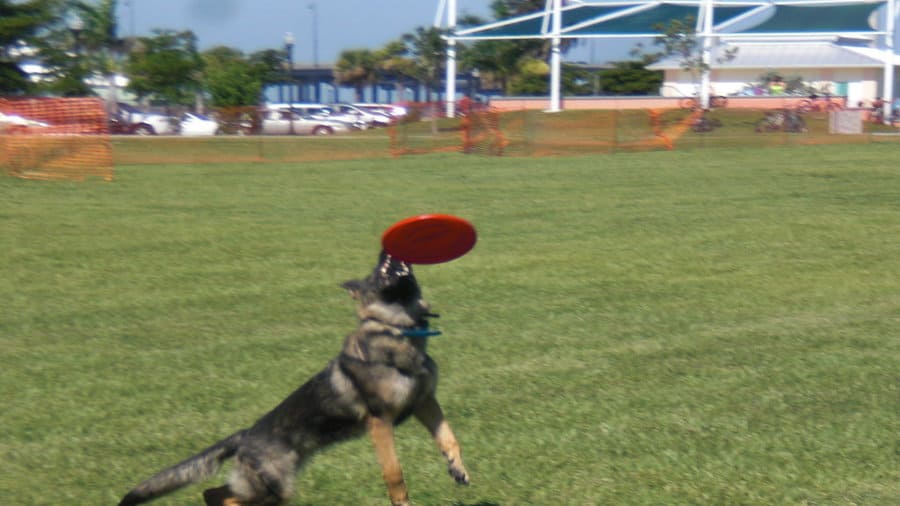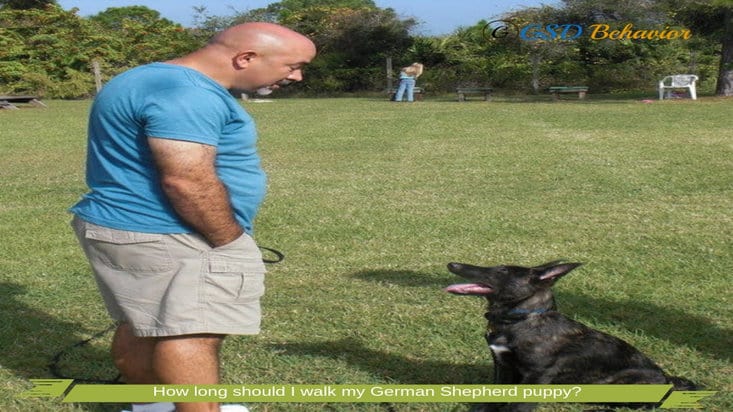If you’re new to owning a German Shepherd puppy, my guess is your looking to find out how much exercise on a daily basis should you give your puppy.
With all my years of owning German Shepherds. I’m going to share my puppy exercise experience with you. My proven step-by-step puppy training guide teaches you everything you need to know about walking a German Shepherd Puppy, from eight weeks to 12 months old.
German Shepherd Puppy Walking: 8-week-to 12-week-old puppy
A good rule of thumb for an eight-week-old German Shepherd puppy. Because puppies are growing, it’s important that you exercise them correctly. I’ve always given my puppies five minutes of exercise multiple times a day.
For example, twice in the morning, early and late afternoon. This has worked the best for me. I recommend you try to incorporate several sessions throughout your day.
Exercise 4-month-old German Shepherd puppy
When my puppies are 4 months of age. I will give them 20 minutes of proper leash walking and fun training exercises for 20 minutes a day. In the morning and early afternoon, and early evening.
Whatever schedule you decide, It’s best to break it up throughout the day to make it work for you and your schedule. We all have to go to work every day.
Exercise 6 month-old German Shepherd puppy
When my puppy was 6 months of age. I will walk them for 35 to 50 minutes twice a day. It’s best to walk early morning when it’s nice and cool out. In the early evening. I teach all my puppies to walk beside me without pulling on a leash. This is a structured walk with proper training. This is how my puppies will get mental stimulation during the walk with the proper physical exercise.
Exercise: 12 month-old German Shepherd puppy

Now that my German Shepherd princess is 12 months old. This is a training video of me training her in some obedience with her favorite toy. I’ve been doing this since she was 4 months of age. Anyone that wants to go out and have fun training their puppy at a young age. Four months is a good time to start basic obedience training.
How to train a German Shepherd not to pull on the leash?
Leash training a three-year-old white female German Shepherd for the first time. A professional dog trainer is demonstrating for the owner, how to leash train her dog to stop pulling. This dog has never been leash trained at all until now. This is her first lesson.
Why I’m using a six-foot leash in this video.
If you have seen any of my other training videos. you know I like to use a long line for all my leash training. But, sometimes we need to do things differently, to help solve a behavior problem.
Because the owner is not physically fit to learn how to use a long line, to leash train her dog. I have to teach her with a 6-foot leash. As dog trainers, we have to be able to help people without getting hurt, do what’s safe for the dog, and the owner.
In this video, the owner is learning what she needs to practice, so she can enjoy walking with her dog. Dog owners need to learn how to apply what they have learned if they want to have a trained dog.
Additional information that can help!
Here are 7 things you should know about giving your GSD dog” the proper exercise.
No matter which breed of dog you choose, part of being a great dog owner is ensuring the physical health of your canine companion. If you’ve chosen to bring a German shepherd home, you’ll need to dedicate yourself to its well-being. In order to make sure that your dog is healthy, and physically fit, you will need to exercise your pet on a daily basis. Here’s what you need to know about exercising your dog:
1. What Age to Start
It’s never too early or too late to start an exercise program with your dog. All ages of dogs benefit from a proper exercise program; starting a fitness regime with your dog as soon as it enters your house will ensure its physical health. Whether you’ve purchased a puppy or adopted an adult dog, establish an exercise program immediately.
2. Importance of Exercise
Exercise benefits dogs in much the same way that it benefits people. Your dog will have a healthier heart, strong muscles, and supple joints if you exercise it daily. Research has shown that dogs that are kept lean through proper diet and exercise live longer than dogs that are rarely exercised. If you want your dog to live as long as possible, an exercise program is incredibly important.
3. Exercise for Puppies
Because puppies are growing, it’s important that you exercise them correctly. The general rule of thumb for puppies is no more than five minutes of forced exercise per month of age. This means that a two-month-old puppy should not be walked for more than ten minutes at a time. Forced exercise is any exercise, such as walking on a leash, which your puppy cannot stop on its own.
4. Exercise for Older Dogs
Your dog is never too old to exercise, provided that he is physically able to do so. As long as your veterinarian gives your senior pet the green light, daily exercise is perfectly safe. Try to remember that your senior may not be able to walk as many miles as she once did; try to take it easy on the old girl. Instead of walking your older dog for 40 minutes at a stretch, take two 20-minute walks during the day.
5. Exercise Ideas
If you aren’t the type of person to walk slowly down the street with your dog, think of ways that your dog can join you in your more adventurous outings. Your dog can jog beside you while you ride your bicycle, he can run while you rollerblade, she can even hike with you through the mountains. There’s virtually nothing that your dog can’t do; from swimming to hiking, your dog can keep up with you as long as he is properly conditioned.
6. Build Up
Don’t think that just because your dog can’t complain about sore muscles she can go from couch potato to 5K runner overnight. Your dog has to be conditioned to exercise just like you do. Spend several weeks building up your dog’s stamina, particularly if you plan on performing some type of strenuous exercise in the near future. For instance, if you will be taking part in a miles-long breast cancer walk, start training with your dog several months ahead of time.
7. Exercise for the Mind
While your dog’s physical health is extremely important, her mental health matters just as much. If you want to tire out your dog or even keep it from misbehaving, making her use her brain is essential. Find toys that your dog can play with that will make her use her mind. Buster Cubes and Kong brand toys are interactive toys that are perfect for dogs of all ages. Additionally, you can play games like “find it” with your pet or take part in competitions like flyball. Anything that makes your dog think will serve to drain her brain. Any dog who is both physically and mentally tired is a dog that is well-behaved.
Physical and mental exercise will keep your dog’s body running in a healthy manner. Your dog will be better behaved, more physically fit, and will live longer if he is properly exercised. Whether you choose to walk your dog, swim with your dog, or enroll your dog into a competition, you will both be better for it.
Remember to consult your veterinarian before you undertake any kind of strenuous physical activity with your canine companion. Provided that your dog is in good physical health, an exercise program will be beneficial and enjoyable for both of you.
I have owned German Shepherds for over 20 years, and I’ve always kept my puppies on this consistent schedule that I’m sharing with you today. I hope you enjoyed it, and I wish you the best of luck with your new German Shepherd puppy.

